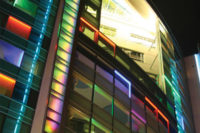
Bringing production in-house
One example, America Search and Rescue (AMERISAR) is a 501(c) 3 non-profit, volunteer-based foundation whose mission is to assist a federal, state, local, public or private agency, organization or person in time of need. The foundation currently provides aid ranging from traffic accidents to lost children and disasters. Identification cards are central to its operations, which involve more than 1,000 volunteers.“Before using the Zebra P310C card printer (Zebra Card Printer Solutions, Camarillo, Calif.), our ID cards were made at small mom and pop shops,” said Larry Kaplan, AMERISAR national director. “However, this meant that anyone could make or duplicate them. We wanted a more secure card and needed to establish control over ID card issuance. That’s when we decided to print them ourselves.”
The organization used plain PVC cards and prints on the front and back. Aside from personal information like name, date of birth, blood type and driver’s license number, the foundation also printed holograms to prevent counterfeiting, alteration or duplication. This was accomplished in a poor man’s printing process of laminating the cards artistically. The holographic image lamination process also provided a very rich looking card. The front featured the individual’s photo, name and title, ID number and a large AMERISAR logo.
By using the latest printing technology, an organization can rest assured it is doing everything it can to prevent identity fraud and to verify that a cardholder is who they say they are.
To prevent counterfeiting, alteration or duplication, there are many techniques that companies can employ with digital printers. First of all, they can deploy multiple security images or holograms. One security image alone increases the difficulty of counterfeiting; two makes it at least twice as hard. The holographic image lamination process also provides a very rich-looking card.

Micro-printing capabilities
End users can also purchase card stock with pre-printed security features, including ultraviolet-visible text and graphics that are available in two colors, green and blue. With micro-printing, text can be added to a user’s specifications, with deliberate random font changes and misspellings if desired. Character height is 5 thousandths of an inch (0.125mm). Pre-printed serial numbers can also be incorporated into card stock. Laser etching is another option.Fine-line Guilloche patterns with hidden micro-text are aimed at foiling counterfeiters, and micro-printing of text and miniature graphic elements are also difficult to duplicate. An over-laminate film adds security to the printed ID card. The inner surface of the laminate can be pre-printed with OVI ink or UV-visible ink in one, two or three colors. And last, but not least, today’s high-tech printers can also laminate with holographic metallization, including embossed micro-text.
Card serialization also adds security. Printers with the magnetic stripe encoder, proximity encoder and smart card contact options can be set up to function only with serial numbered card stock.
Sidebar: Why Multiple Technologies on a Single Card?
Using multiple technologies to enhance the security of a card just makes sense. With a photograph alone, security personnel can be fairly certain that the person holding the card is the person in the photo. With a legible signature, the end user can add another level of certainty that the cardholder is who she claims to be. Holograms, micro printing, and UV text help ensure that the card has not been counterfeited – that the card was issued by the agency it was purported to be issued by. Adding encoded information to a barcode or magnetic stripe, such as a hidden serial number, or detailed physical characteristics of the cardholder, adds even more security to the card.
A smart card with an embedded computer microchip can even hold a biometrics template that positively identifies the cardholder by a unique physical characteristic, such as the shape of a hand or a fingerprint.


